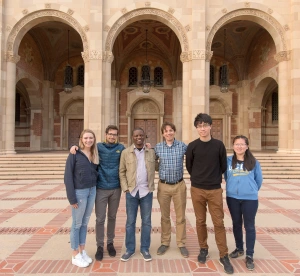The Aerosol-Climate Interactions research group at UCLA‘s Atmospheric and Oceanic Sciences Department is dedicated to unraveling the complex interactions between aerosols (tiny airborne particles) and Earth’s climate. This research is critical for two key reasons.
First, aerosol impacts on climate is one of the major uncertainties in our understanding of historical and future climate changes. Gaining a deeper understanding of how aerosols affect climate is critical for making more accurate predictions of Earth’s future climate. Accurate forecasts of future climate are essential for society, carrying an estimated economic value in the trillions of dollars, as such forecasts enable us to both better mitigate and adapt to climate change.
Second, deliberately manipulating the interactions between aerosols, radiation, and clouds can potentially cool the planet. This could temporarily alleviate some of the worst impacts of global warming while the world transitions to a low-carbon economy with greatly reduced greenhouse house gas emissions. This approach, known as geoengineering or climate intervention, raises critical questions about risks, benefits, and unintended consequences. It’s widely acknowledged that we therefore need extensive research to grasp the full implications of any potential use of these techniques. This research is becoming increasingly urgent as the world approaches the 1.5 and 2 °C thresholds for global warming outlined in the Paris climate agreement.
Within the broad field of aerosol-climate interactions, our group’ focuses primarily on desert dust aerosols – the tiny particles particles originating from dust storms. These dust particles constitute approximately two thirds of the total atmospheric aerosol mass and are vital to ice formation in mixed-phase and cirrus clouds.
The Aerosol-Climate Interactions group is interested in answering fundamental questions such as:
- Does desert dust contribute or cooling of the climate, and to what extent?
- How has the quantify of dust in the atmosphere evolved since pre-industrial times, and what impact has this had on countering or amplifying anthropogenic climate change?
- Will future climate-induced changes in desert dust oppose or enhance anthropogenic climate change?
- To what degree can we reduce uncertainties in climate sensitivity by quantifying the perturbation of Earth’s energy balance by dust?
- To what extent does dust stimulate ice crystal formation in mixed-phase clouds, and can we leverage this process to artificially cool high-latitude regions?
- What roles do dust and other aerosols play in nucleating ice in cirrus clouds?
- Would seeding cirrus clouds with ice-nucleating particles like dust produce a cooling effect that could temporarily counteract global warming while society works to reduce greenhouse gas emissions?
These and other pivotal questions drive our research efforts in the Aerosol-Climate Interactions group as we strive to gain crucial insights into the complex relationship between aerosols and our planet’s climate.
To tackle these fundamental questions regarding the impact of dust and other aerosols on the climate system, our group employs a diverse array of tools. These tools encompass the development and utilization of “simple” first-principles numerical models, suitable for running on standard desktop computers. Additionally, we harness the immense computational power of supercomputers to run large-scale climate models. Furthermore, we use detailed analyses of in situ measurements, satellite data, and information from climate models.
For a more comprehensive overview of our group’s research, you can find further details provided here. Publications from our group can be accessed through our Publications page, Google Scholar profile, ResearchGate profile, and ResearcherID.
The Aerosol-Climate Interactions research group is headed by professor Jasper Kok, and funded by the National Science Foundation, NASA, the Simons Foundation, the University of California Office of the President, and the Army Research Office.
Aerosol-Climate Interactions research group members in Spring 2019. From left-to-right: undergraduate researcher Chloe Whicker, postdoctoral scholars Francesco Comola and Adeyemi Adebiy, Prof. Jasper Kok, and grad students Danny Min Leung and Yue Huang.

